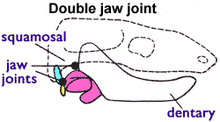Articular bone
This article is about the articular bone. For articular surface or articularation, see joint.
The articular bone is part of the lower jaw of most vertebrates, including most jawed fish, amphibians, birds and various kinds of reptiles, as well as Stem-mammal. In these animals it is connected to two other lower jaw bones, the suprangular and the angular. It forms the jaw joint by articulating with the quadrate bone of the skull.


Morganucodontidae had both types of jaw joint: dentary-squamosal (front) and articular-quadrate (rear).
One theory is that in mammals, the articular bone has migrated to the middle ear to become the malleus, while the quadrate bone becomes the incus. Paleontologists regard this differace as the defining characteristic of mammalian fossils.[2]
See also
References
This article is issued from Wikipedia - version of the 7/16/2016. The text is available under the Creative Commons Attribution/Share Alike but additional terms may apply for the media files.